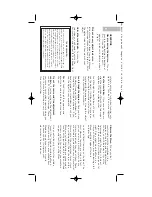
tr
acks). Viewing fr
om the upper fl
oor
s of a
building may also c
ause image mo
vement.
Let y
our e
y
es “dark-adapt”:
All
o
w
fiv
e or
ten minut
es f
or y
our e
yes t
o
bec
ome “dark
adapt
ed” bef
or
e observing. Use a r
ed-
filt
er
ed flashlight t
o
pr
ot
ect y
our night vision
when r
eading s
tar maps, or inspecting the
te
lesc
ope. Do not use use a r
egular flash-
light or turn on other lights when observing
with a gr
oup of other as
tr
onomer
s. Y
ou c
a
n
mak
e y
our own r
ed filt
er
ed flashlight by
taping r
ed c
ell
ophane o
ver a flashlight l
ens.
Vie
wing thr
ough windo
ws
: A
void setting up
the t
e
lesc
ope inside a r
oom and observing
thr
ough an opened or cl
osed window pane.
Images may appear blurr
ed or dis
tort
ed due
to
t
emper
atur
e diff
er
enc
es between inside
and outside air
. Also, it is a good idea t
o
all
o
w
y
our t
e
lesc
ope t
o
r
each the ambient
(surr
ounding) outside t
emper
atur
e bef
or
e
s
tarting an observing ses
sion.
When to observ
e
: Planets and other objects
viewed l
o
w on the horizon oft
en lack sharp-
nes
s—the same object, when observ
ed
higher in the sky, will appear sharper and
hav
e gr
eat
er c
o
ntr
a
s
t. T
ry r
educing pow
e
r
(change y
our e
yepiec
e) if y
our image is fuzzy
or shimmer
s. Keep in mind that a bright,
cl
ear, but small
er image is mor
e
int
er
es
ting
than a lar
ger, dimmer, fuzzy one. Using t
o
o
high a pow
e
r e
yepiec
e is one of the mos
t
c
ommon mis
ta
k
es made by new
as
tr
onomer
s.
Dr
es
s W
arm
: Ev
en on summer nights, the
air c
an f
eel c
ool or c
old as the night wear
s
on. It is import
ant t
o
dr
es
s warm or t
o
hav
e
a sweat
er, jack
et, gl
o
ves, et
c., nearby
.
Kno
w y
our observing site
: If pos
sibl
e, know
the l
o
c
ation wher
e y
ou will be observing. P
a
y
att
ention t
o
hol
es in the gr
ound and other
obs
tacl
es. Is it a l
o
c
ation wher
e wild
animals, such as skunks, snak
es, et
c., may
appear? Ar
e ther
e viewing obs
tructions
such as t
all tr
ees, s
tr
eet lights, headlights
and so f
orth? The bes
t l
o
c
ations ar
e dark
lo
c
ations, the dark
er the bett
er
. Deep spac
e
objects ar
e easies
t t
o
see under dark skies.
But it is s
till pos
sibl
e t
o
observ
e e
ven in a
city
.
Surf the W
eb and visit y
our l
o
cal libr
ary
:
The int
ernet c
ont
ains a huge amount of
as
tr
onomic
al inf
ormation, both f
or childr
en
ASTRONOMY RESOURCES
•
The Meade 4M Community
6001 Oak Cany
on, Irvine, C
A
92618
•
A
s
tr
onomic
al League
Ex
ecutiv
e Secr
et
ary
5675 Real del Nort
e, Las Cruc
es, NM 88012
•
The As
tr
onomic
al Society of the P
acific
390 Asht
on A
venue, San F
rancisc
o, C
A
94112
•
The Planet
ary Society
65 North Cat
alina A
venue, P
asadena, C
A
91106
•
Int
ernational Dark-Sky As
sociation, Inc.
3225 N. Fir
s
t A
venue, T
ucson, AZ 85719-2103
and adults. Check out as
tr
onomy
books fr
om y
our libr
ary
. Look f
or s
tar
charts—these ar
e av
ailabl
e on a
monthl
y basis in
Astronomy
and
Sky
and Telescope
magazines.
HA
VE A GOOD TIME,
ASTRONOMY IS FUN!
SPECIFIC
A
TIONS
Optic
al
tube
fo
c
al
length
. . . . . . . . . 700mm
Objectiv
e
lens
diamet
er
. . . . . . 60mm
(2.4")
F
o
c
al
ratio
. . . . . . . . . . . . . . . . . . . . . . . f/11.7
Mounting
type
. . . . . . . . . . . . . . . Alt
azimuth
11
40-04135 8 Page Manual Template 6/29/05 10:54 AM Page 13































